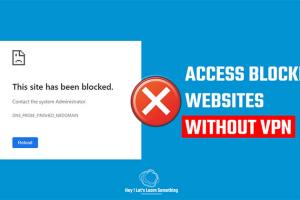Access Blocked Sites: No VPN Needed | Simple Methods for School, Work, and Home

-
Quick Links:
- Introduction
- Understanding Why Sites are Blocked
- Methods to Access Blocked Sites Without a VPN
- Case Studies
- Expert Insights
- Additional Tips
- FAQs
Introduction
In today’s digital age, accessing information online is a fundamental part of both education and work. However, many institutions implement restrictions that block access to certain websites. Whether you're at school, at work, or even at home, there may be times when you encounter these barriers. This article will guide you through various methods to access blocked sites without using a VPN, making it easier to navigate the internet freely.
Understanding Why Sites are Blocked
There are several reasons why websites may be blocked:
- Institutional Policies: Schools and workplaces often restrict access to prevent distractions.
- Content Filtering: Certain content may be deemed inappropriate or harmful.
- Legal Restrictions: Some sites may be blocked due to local laws.
Understanding these reasons can help you find appropriate ways to access blocked content responsibly.
Methods to Access Blocked Sites Without a VPN
Now that you know why sites are blocked, let’s explore effective methods for accessing them without a VPN.
1. Using Proxy Servers
Proxy servers act as intermediaries between your device and the internet. By routing your request through a proxy, you can access blocked websites. Here’s how to do it:
- Find a reliable web-based proxy service.
- Enter the URL of the blocked site in the proxy's address bar.
- Access the website through the proxy server.
Some popular web-based proxy services include:
2. Using Tor Browser
Tor is a browser designed for anonymous browsing. It can help you access blocked sites through its network of volunteer-operated servers:
- Download and install the Tor Browser.
- Open the Tor Browser and enter the URL of the blocked site.
- Enjoy anonymous browsing!
3. Changing DNS Settings
Sometimes, changing your DNS settings can help you bypass restrictions:
- Go to your device's network settings.
- Change your DNS to a public DNS, such as Google DNS (8.8.8.8 and 8.8.4.4) or Cloudflare DNS (1.1.1.1).
- Try accessing the blocked site again.
4. Using IP Address Directly
Instead of typing the URL, you can try using the website's IP address. Here’s how:
- Find the IP address using a service like WhatIsMyIP.
- Enter the IP address in your browser’s address bar.
- If the site is still accessible, you’ll be able to view it directly.
5. Utilizing Browser Extensions
Several browser extensions can help bypass restrictions:
Case Studies
To better understand the effectiveness of these methods, here are some real-world case studies:
Case Study 1: School Restrictions
A high school student faced restrictions on social media access during school hours. By using a web proxy service, they successfully accessed the sites during breaks without triggering any alarms from the school's network monitor.
Case Study 2: Corporate Environment
In a corporate environment, an employee needed access to a blocked research site. By changing their DNS settings to Google's public DNS, they were able to access the site without any issues.
Expert Insights
Experts suggest that while these methods can be effective, users should always consider the legality and ethical implications of bypassing network restrictions. Depending on your location, accessing certain content may breach local laws.
Additional Tips
Here are some additional tips to ensure safe and efficient access to blocked sites:
- Always check the credibility of proxy services.
- Be cautious about sharing personal information while using proxies.
- Use HTTPS sites for better security.
FAQs
1. Is it legal to access blocked sites?
It depends on local laws and the policies of your institution. Always check the legality before attempting to bypass restrictions.
2. Can I use my mobile data to access blocked sites?
Yes, if you're on mobile data, you can bypass local Wi-Fi restrictions and use any of the methods mentioned.
3. Are there risks associated with using proxy servers?
Yes, some proxy servers may log your data or expose you to malware. Always use reputable services.
4. Can I use these methods at work?
While you can use these methods, be aware that bypassing work restrictions may violate your company’s policy.
5. What if the site is still blocked even after using these methods?
Some networks may implement strict measures. Consider trying a different method or discussing the access issue with your network administrator.
6. Do I need technical knowledge to use these methods?
No, most methods are user-friendly and require minimal technical knowledge. Follow the step-by-step guides provided.
7. Are there any free alternatives to VPNs?
Yes, using proxy servers or browser extensions can be free alternatives to VPNs.
8. Can I access blocked sites on public Wi-Fi?
Yes, but be cautious of security risks. Always use HTTPS and avoid entering sensitive information.
9. How can I ensure my privacy while accessing blocked sites?
Consider using the Tor browser for enhanced privacy while accessing blocked sites.
10. What are some common websites that are blocked?
Commonly blocked websites include social media platforms, streaming services, and gaming sites.
Random Reads
- How to navigate to a different folder in command prompt
- Mastering google chrome guide
- Mastering google hangouts
- Unlock microsoft office free ways
- Unlock bowser jr mario kart wii
- Mastering dll file editing visual studio
- Mastering document preservation
- How to repair windows 7
- How to repair water damaged iphone
- How to repair a cracked mirror